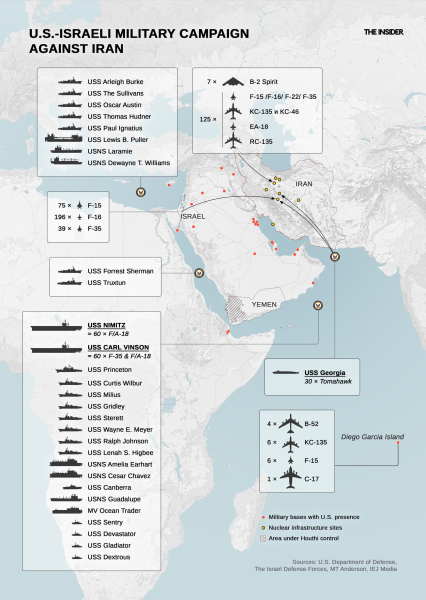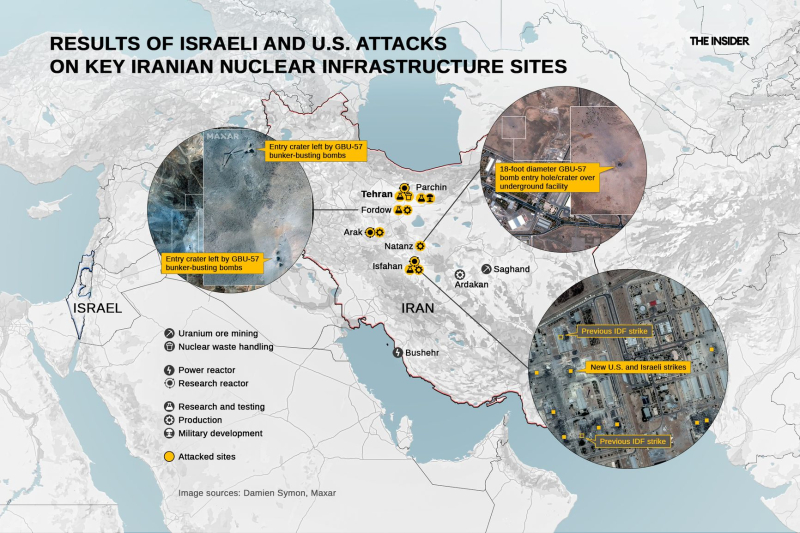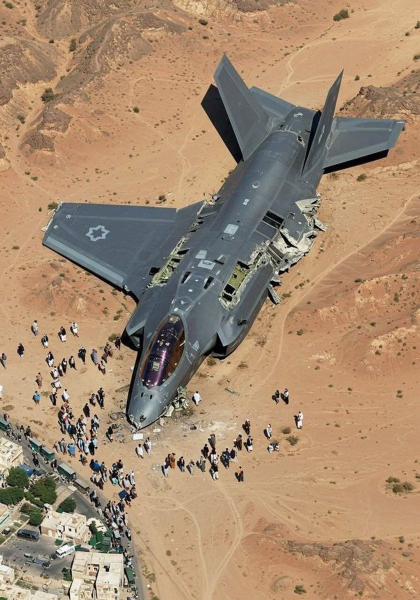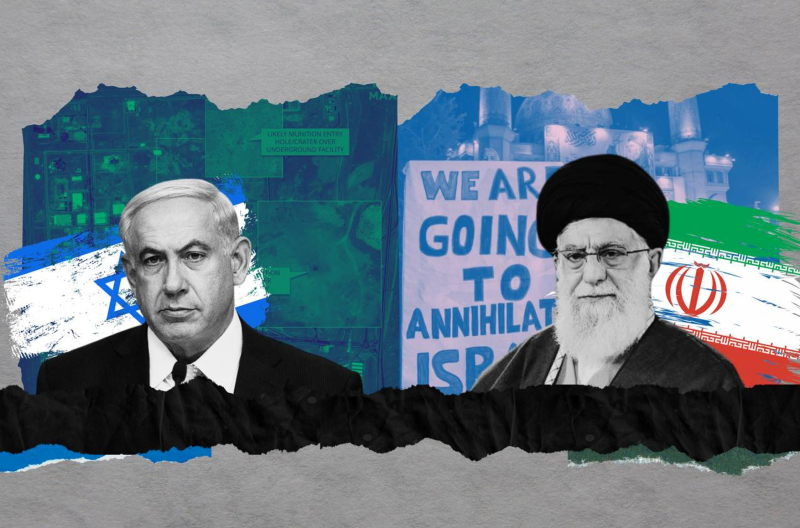Cover image: The Insider
Israel is preparing to execute new strikes on Iran in the event Tehran attempts to revive its nuclear program, and according to Ron Dermer, a top advisor to Prime Minister Benjamin Netanyahu, Jerusalem is counting on U.S. support. Three weeks after the U.S.-Israeli coalition’s military operation, the results are mixed: tactically, the brief campaign was overwhelmingly effective, but it fell short of meeting several key strategic goals. Israeli airstrikes swiftly disabled much of Iran’s air defenses, disrupted command-and-control networks, and hit hundreds of military, nuclear, and defense infrastructure targets across the country. U.S. follow‑on attacks using high‑penetration bunker‑buster bombs struck major sites connected to Iran’s nuclear program, but by every indication they did not attempt to reach deeply buried sections of the Isfahan Nuclear Research Center. In the end, critical Iranian resources and equipment remain intact, enabling a potential rapid resumption of nuclear weapons development. Israel now faces a choice: launch a new, ground‑penetrating military operation deep into Iranian territory, or pursue a new diplomatic agreement on Tehran’s nuclear program.
In the predawn hours of Friday, June 13, Israel launched a massive airstrike across Iran. Defense Minister Israel Katz described the mission as “preemptive,” aimed at preventing Iran from obtaining nuclear weapons.
The operation, code‑named “Am K'Lavi” (“Rising Lion”), draws its name from Numbers 23:24:
“Behold, the people shall rise up as a great lion, and lift up himself as a young lion: he shall not lie down until he eat of the prey, and drink the blood of the slain.”
As The Insider reported in April, such a military operation was likely to begin shortly after the expiration of the 60-day window Donald Trump had set for a diplomatic resolution, provided that those efforts failed. The indirect U.S.-Iran talks began in Oman on April 12, and the IDF launched airstrikes on the night of June 13 — 61 days later.
The Israeli Air Force launched its operation against Iran immediately after the 60-day deadline set by Donald Trump for a diplomatic solution had passed.
The campaign expanded on the night of June 22, when the U.S. Air Force and Navy joined Israel’s attacks under operation «Midnight Hammer.“ Seven B‑2 stealth bombers dropped GBU‑57 Massive Ordnance Penetrators — each weighing over 13 tons — on nuclear complexes at Fordow and Natanz. Concurrently, 30 Tomahawk cruise missiles were launched from the submarine USS Georgia (SSGN‑729) at Natanz and the Isfahan nuclear research site. The raid involved more than 125 aircraft, including fighter escorts, EW (electronic warfare) planes, AWACS aircraft, and tankers.

B-2 bombers struck Iranian targets directly from a U.S. base, completing the mission without stopovers and spending 37 hours in the air. They were supported by naval groups operating in the Mediterranean, the Red Sea, and the Arabian sea — including two carrier strike groups led by the USS Carl Vinson (CVN-70) and USS Nimitz (CVN-68), each with its own air wing.
Following a symbolic Iranian missile strike on a U.S. base in Qatar, both sides agreed to a cease-fire. The military operation against Iran lasted 12 days, from June 13-24.
Campaigning against nuclear sites in Iran represents a further escalation of the larger regional war that began with Hamas’s attack on Israel on Oct. 7, 2023.
Israel achieved operational surprise and carried out a «decapitation strike» within days of starting the operation. Iran’s top military leadership was reportedly eliminated, including armed forces chief of staff Mohammad Bagheri and IRGC commander Hossein Salami.
Iran reportedly lost 11 nuclear scientists and 30 generals in just 12 days. By comparison, Russia has lost slightly more than ten generals during its ongoing war in Ukraine, which is now well into its fourth year.
Iran acknowledged the deaths of 30 generals in just 12 days.
The high number of Iranian generals killed was the result of successful special operations by Israeli intelligence. In one case, Israeli operatives tricked Iran’s air force leadership into gathering in a single location, which was then hit in a targeted strike. Israeli intelligence also established a drone base inside Iranian territory in order to strike air defenses ahead of the first wave of air raids. They also used mobile drone launchers disguised as civilian trucks — a tactic previously employed by Ukrainian intelligence to target Russian long-range aircraft in Operation Spiderweb — and remotely operated anti-tank missile systems.
Just days into the operation, the Israeli Air Force had secured sufficient air dominance to switch from expensive long-range missiles to cheaper munitions. This stood in stark contrast to the performance of the Russian Air Force in Ukraine, where it has still failed to achieve air superiority, even near the front lines. However, Israeli dominance was largely limited to western Iran, where the air defense systems were less dense and not as technologically advanced as those deployed in Ukraine.
Just days into the operation, the Israeli Air Force had secured sufficient air dominance in western Iran.
Over the course of 12 days, the Israeli Air Force completed 1,500 sorties and over 500 armed drone missions, striking approximately 1,500 targets across 900 sites, including over-the-horizon radar systems, radar stations, missile and ammunition depots, airfields, command posts, defense industry facilities, and government buildings. Visually confirmed Iranian losses were relatively minor: fewer than 100 weapons systems and military vehicles, including outdated rarities such as F‑14 jet fighters.
The campaign’s primary objectives were Iran’s missile and nuclear programs.
Israeli aircraft struck more than 20 missile bases in western and central Iran. These sites included extensive underground storage, meaning that even if surface access points were destroyed, missiles could still be unearthed later. Launch platforms proved more critical: without them, missile stockpiles cannot be deployed. Official Israeli estimates claim that approximately 50-60% of Iran’s estimated 200-250 launchers were destroyed.
But the reported number of destroyed missile launchers may be significantly inflated. Visual confirmation exists for only 60 units, and one alternative estimate puts the figure at just 20. Moreover, some footage released by the Israeli side shows strikes on launchers that were clearly not combat-ready, including outdated Elbrus tactical systems. Decoys designed to resemble launchers were also among (1, 2) the confirmed targets.
The reported number of destroyed missile launchers may be significantly inflated.
Crucially, Iran confirmed the deaths of more than 50 missile launch operators from the IRGC’s Aerospace Forces. This suggests that, at the very least, dozens of deployed and launch-ready systems were successfully targeted, likely after being identified in advance by Israeli aerial reconnaissance. This is crucial given that, aside from a limited number of loitering munitions and cruise missiles, nearly all of Iran’s airstrike capabilities against Israel are controlled by the IRGC Aerospace Forces.
Assessing the effectiveness of the campaign against Iran’s nuclear program is more difficult. During the 12-day conflict, nearly all of Iran’s major known nuclear sites — including the Fordow and Natanz facilities and the Isfahan Nuclear Research Center — came under repeated attack. At Fordow and Natanz, bunker-busting GBU-57 bombs reportedly reached underground sections. However, in Isfahan, U.S. forces did not attempt to strike the deeply buried infrastructure, as it lies beyond the penetration capabilities of the GBU-57.

On the night of June 14, Iran began launching retaliatory strikes against Israel, using mostly medium-range ballistic missiles (MRBMs) and Shahed-type loitering munitions, well-known from their continued and extensive use by Russia in its war against Ukraine.
However, the intensity of the missile barrages was lower than expected. After simultaneous salvos of 40 to 50 missiles per day in the first three days, the attacks tapered off to sporadic launches in the final days. According to official Israeli estimates, Iran launched a total of 631 missiles over the 12-day conflict. Of those, 500 reached Israeli territory, with 243 falling in unpopulated areas. Israeli air defenses intercepted 221, while 36 managed to hit their targets.
This gives an interception rate of just 86% (221 out of 257 incoming missiles). Viewed against the total number of launched missiles, about 6% — or 36 — struck targets in Israel. The total damage in Israel is estimated at $3 billion, though that figure could rise above $10 billion. Civilian casualties totaled 28 dead and 1,472 injured, with over 2,300 apartments damaged across 240 residential buildings.
In contrast, independent estimates in Iran suggest roughly 1,100 people were killed and another 4,500 wounded — a count that includes both military personnel and civilians.
Israel's air defense interception rate during Iran’s retaliatory attacks was only 86%.
The cost of operating Israel’s air defense systems over the course of the conflict ran to more than $1 billion. Each interceptor for ballistic missiles costs several million dollars, with American-made THAAD interceptors priced at nearly $13 million apiece. Over the 12 days of strikes, at least 39 THAAD interceptors were used — more than the annual production of ammunition for the system.
Ultimately, Iran’s medium-range ballistic missiles (MRBMs) demonstrated their ability to overwhelm and penetrate what is likely the most layered and advanced missile defense system in the world. Had Iran possessed nuclear weapons, it would likely have been able to use them against Israel during its sustained missile salvos.
Had Iran possessed nuclear weapons, it would likely have been able to use them against Israel.
Drone attacks, by most accounts, proved far less effective. While some unmanned aerial vehicles were intercepted near Israeli air defense zones, Israel estimates that Iran launched roughly 1,000 drones, of which only one managed to avoid interception.
Iranian forces appear to have failed to inflict any confirmed military damage on Israel, though that assessment could change if satellite imagery verifies hits on a handful of sites that are rumored to be undisclosed Israeli military bases.The only visually confirmed Israeli losses were five drones — a total that likely includes two units that were shot down by Iranian air defense, while the rest were lost to friendly fire. Meanwhile, Iran found greater success online, where its specialists used AI-generated imagery to “destroy” numerous unidentified aircraft in cyberspace — fooling some readers but not actually diminishing Israel’s military capacity.

Following the initial “decapitation strike” in the early days of the campaign, Iran’s Armed Forces and the IRGC quickly restored command and control, resuming regular missile attacks that were mainly launched from remote bases in the central and eastern parts of the country. After the U.S. strike on Iran’s nuclear facilities, Tehran carried out a symbolic operation against a U.S. base in Qatar. Iranian officials issued a prior warning about the strike, and the move was widely seen as a way for Iran to save face.
Since Oct. 7, 2023, Israel has faced the threat of simultaneous war on seven fronts or theaters of operations:
- the Gaza Strip, where Hamas and its allied factions are active;
- southern Lebanon, controlled by Hezbollah;
- border areas of Syria under Bashar Assad’s regime;
- Shiite militias in Iraq;
- the Houthi movement in Yemen;
- the West Bank (referred to in Israel as Judea and Samaria);
- and Arab-majority towns within Israel’s internationally recognized territory.
Iran had spent decades investing in the creation of anti-Israeli armed groups in each of these areas, an effort that effectively deterred Israel from attacking Iran directly lest Tehran’s proxies in the region retaliate against the Jewish state from multiple directions. But nearly two years into the war, most of those links have been severed or critically weakened, and the fighting has now finally shifted onto Iranian territory.
The most significant development was the collapse of Bashar al-Assad’s regime in Syria in December, cutting Iran off from its Lebanese allies and enabling the Israel Defense Forces to clear Syrian territory of air defense systems. During Operation Rising Lion, Israeli aircraft operated freely in Syrian airspace, launching strikes and carrying out mid-air refueling.
And yet, contrary to the claims of U.S. President Donald Trump, neither Iran’s missile and nuclear programs have not been fully destroyed. The debate now centers on whether those programs were set back by years, or merely by months. European intelligence agencies assess that Iran has largely preserved its stockpile of enriched uranium.
At best, Iran’s nuclear program was set back by several years.
Maxim Starchak, a research fellow at the Centre for International and Defence Policy at Queen’s University in Canada, wrote in his column for The Insider that Iran has also undoubtedly retained its scientific and technical expertise, as Tehran likely established backup uranium enrichment facilities in advance. That means the country’s progression toward building a nuclear weapon remains a political decision by its leadership, as the technical capacity to do so remains.
The dismantling of its regional deterrence network, along with the overwhelming conventional military superiority demonstrated by the U.S.-Israeli coalition, may incentivize Tehran to pursue the nuclear option even more aggressively. e network by Israel and. Iran’s missile forces proved they could breach even Israel’s layered air defenses, meaning that of the two core components of a nuclear weapons program — delivery systems and warheads — Iran effectively has the first. Intelligence that Iran may have been preparing to integrate a nuclear payload into its missiles was reportedly what triggered the Israeli operation in the first place.
Of the two core components of a nuclear weapons program — delivery systems and warheads — Iran effectively has the first.
As before, the U.S. and Israel will need to negotiate controls over Iran’s nuclear facilities and missile development. But Tehran has suspended cooperation with the International Atomic Energy Agency (IAEA). The fate of 400 kilograms of uranium enriched to 60%, enough for at least nine nuclear warheads, remains unknown. For Israel, that uncertainty creates an intolerable level of strategic ambiguity.
If diplomacy fails, another military operation may be back on the table. Since U.S. forces have effectively acknowledged they cannot reach the underground halls of the Isfahan nuclear research center from the air, a different deep-penetration approach would be required — likely involving sabotage teams inserted directly into the facility. According to recent reporting, Israel is now actively considering such a mission.



